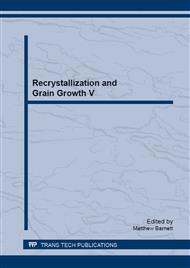p.21
p.25
p.31
p.37
p.42
p.46
p.50
p.54
p.58
Texture and Microstructure Evolution of a Zirconium Alloy During Uniaxial Compression at 500°C
Abstract:
The texture and microstructure evolution during uniaxial compression of Zircaloy-4 at 500C has been studied. X-ray diffraction was used to measure the bulk texture compressive after strains of 20% and 50%. Early stages of texture evolution involve the strengthening of the fibre through the action of prismatic slip. With further deformation, the basal poles move toward the rolling direction from the normal direction as a result of a non-prismatic slip system. A detailed EBSD study in a small region showed that the grains of the fibre are more stable than those of the fibre. The latter rotates further during deformation and shows a greater spread of grain average misorientation (GAM). This could be due to a greater accommodation of plastic strain in these grains and/or a difference in recovery rates between the two fibres.
Info:
Periodical:
Pages:
42-45
Citation:
Online since:
March 2013
Keywords:
Price:
Сopyright:
© 2013 Trans Tech Publications Ltd. All Rights Reserved
Share:
Citation:


